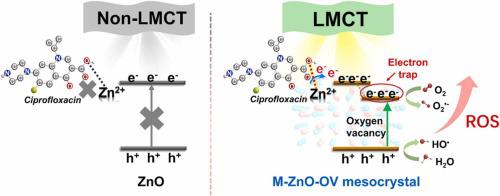Applied Catalysis B: Environment and Energy ( IF 20.2 ) Pub Date : 2022-10-01 , DOI: 10.1016/j.apcatb.2022.122033 Minxian Zhang , Xuecong Lin , Ziran Yi , Xiang Xu , Jingling Yang , Mingshan Zhu

|
Through visible light driven ligand-to-metal charge transfer (LMCT) with organic pollutant-semiconductor is a new method to promote reactive oxygen species (ROS) generation in water treatment. This study is the first time to use ciprofloxacin (CIP) pollutants induced LMCT on ZnO mesocrystal with rich oxygen vacancies (M-ZnO-OV) to improve ROS generation for CIP self-degradation. The results show an obviously increased intensity of HO• and O2•− through the LMCT process, leading to the optimal kinetic rate constant of 0.043 min–1 for CIP degradation, which is 7.5 times that of ZnO non-LMCT process. The presence of oxygen vacancies (OVs) in M-ZnO-OV leads to an electron-deficient Zn atom nearby OVs, promoting the formation of LMCT complex, and then resulting in rapid electron transfer from OVs to oxygen in water to generate ROS. The present investigation provides a new OVs-enhanced LMCT process to improve the concentration of ROS for water treatments.
中文翻译:

富氧空位 ZnO 介晶与环丙沙星污染物之间的配体-金属电荷转移增强活性氧化物质的产生
通过可见光驱动的配体-金属电荷转移(LMCT)与有机污染物-半导体是一种促进水处理中活性氧(ROS)生成的新方法。本研究首次使用环丙沙星(CIP)污染物诱导的富氧空位氧化锌介晶(M-ZnO-OV)上的LMCT来改善CIP自降解的ROS生成。结果表明,通过 LMCT 过程,HO •和 O 2 •-的强度明显增加,导致最佳动力学速率常数为 0.043 min –1对于 CIP 降解,是 ZnO 非 LMCT 工艺的 7.5 倍。M-ZnO-OV 中氧空位 (OVs) 的存在导致 OVs 附近的缺电子 Zn 原子,促进 LMCT 复合物的形成,然后导致电子从 OVs 快速转移到水中的氧以产生 ROS。本研究提供了一种新的 OVs 增强 LMCT 工艺,以提高水处理中 ROS 的浓度。

































 京公网安备 11010802027423号
京公网安备 11010802027423号